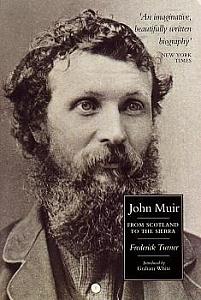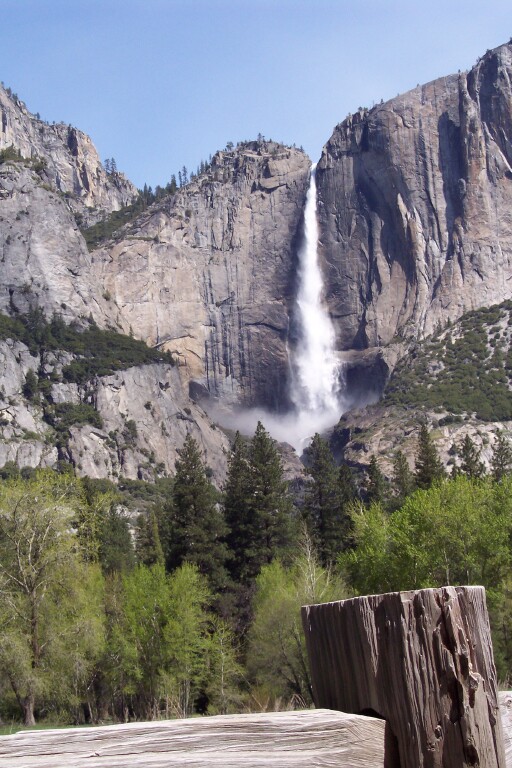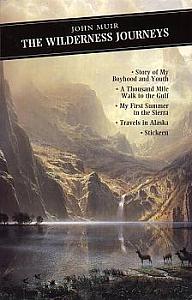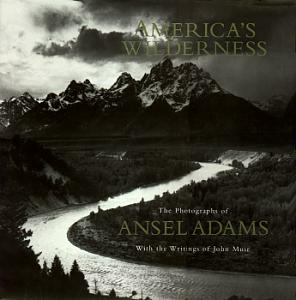Father of the American National Parks
John Muir is one of that large band of Scots who is world
renowned but until a few years ago was hardly known in his own country. In his case it is
partly because he left Scotland at quite an early age. He is rightly regarded as one of
the fathers of the modern conservation movement and his name is a source of inspiration to
naturalists the world over; now at last he is being honoured in his native land.

He was born in Dunbar on the 21st April 1838 and emigrated to
the United States along with his family in 1849. They settled in Wisconsin and he spent
the next ten years working 12 hours a day helping his father to create a farm in the
wilderness area they were faced with. His formal schooling had ended when the family
reached America, but he was a voracious reader and like many men of genius was adept at
self-teaching. A talent for invention was allied to excellent manual skills and with no
training he was able to make clocks and other intricate machines out of hickory. This
inventiveness led to a scholarship at Wisconsin University and later to work in industry,
where his ability to improve and develop machinery was much admired, but an accident in
which a tool pierced his eye and left him temporarily blinded forced him to re-evaluate
his priorities. He turned to his interests as a naturalist and botanist and before long he
set off on his celebrated 1000 mile walk to the Gulf of Mexico.
Muir went to California in 1868 and spent six years,
initially as a shepherd and later studying and exploring, in the Yosemite Valley and the
High Sierras. He had a great love of these wild places, and was horrified by man's impact
on the often fragile environment. He wrote extensively about the geological and natural
history of the region; the history of the glaciers, about the trees and their patterns of
growth, the animals and their habitat, but above all about the landscape and the indelible
impression it made upon him.
| "When I was a boy in Scotland I was fond of
everything that was wild... I loved to wander in the fields to hear the birds sing, and
along the shore to gaze and wonder at the shells and seaweeds, eels and crabs in the pools
when the tide was low; and best of all to watch the waves in awful storms thundering on
the black headlands and craggy ruins of old Dunbar Castle." |
In 1880, after working in Nevada, Utah, and Colorado, and
visiting Alaska for the first time, he returned to California and set up home there
following his marriage. There followed a period in which he withdrew from conservation
work and concentrated on his new responsibilities running the wineyards and fruit farms of
his new home in order to secure his family's future. However this caused him so much
strain that he was frequently sent off on trips by his wife and by 1888 he was persuaded
to return to his writing and conservation work at a time when the US government was
returning public domain land to private hands and in the process setting off a period of
land speculation which threatened the wilderness that he held so dear.
Although not entirely alone in his work Muir was largely
responsible for inspiring the American people and alerting them to the possible loss of
the wilderness areas, and through his petitioning of Congress, for the setting up in 1890
of Sequoia National Park and Yosemite National Park, which covers roughly a quarter of a
million square miles. In 1892 he set up the Sierra Club, which would later have people such as Ansel Adams, the
outstanding landscape photographer, on its Board of Trustees. His later defence of the
forest parks against powerful lobbying from those who wanted to take back the forest and
strip out the timber has inspired generations of conservationists the world over.

Waterfall at the
Yosemite National Park
| "Thousands of tired nerve-shaken, over civilized
people are beginning to find out that going to the mountains is going home; that
wilderness is a necessity and that mountain parks and reservations are useful not only as
fountains of timber and irrigating rivers, but as fountains of life." |
Despite spending most of his life in America, Muir always
considered himself a Scot, only taking American citizenship late in life. He returned to
Scotland on a visit in the 1890s and visited the places of his youth which were deeply
etched in his memory. This included his old school where his memories were of a somewhat
mixed nature, for he recalled "If we failed in any part, however slight, we were
whipped; for the grand simple all-sufficing Scotch discovery had been made that there was
a close connection between the skin and the memory, and that irritiating the skin excited
the memory to any required degree. Despite this recollection he was warmly welcomed by the
Schoolmaster, who it turned out had read his books.
In California, Muir is regarded with great pride as a
national hero, and the schoolchildren are taught the lessons of his work. The 21st of
April is officially declared John Muir Day across the state. There is a glacier, a wood
and a national monument named after him. Happily he has at last been fully recognised in
his home country and there are two trusts which bear his name - The John Muir Birthplace
Trust which was set up to purchase the house in Dunbar where he was born and turn it
into an interpretive centre, and The John Muir
Trust, established in 1983, which purchases key tracts of wild land in Scotland to
preserve it from inappropriate development and promote its use for recreational and
educational purposes. In recent years interest in him has begun to blossom, and the
excellent biography by Frederick Turner, published here by Canongate in 1997 (the first to
be published in Scotland since Muir's death in 1914) has done much to bring him to public
attention. There is a 1660 acre John Muir Country Park near Dunbar and a John Muir Award
for environmental endeavors by young people in Scotland, while at Edinburgh University the
new Centre for the Study of Environmental Change and
Sustainability is housed in the John Muir Building. Muir's books, which for many years
were unavailable in this country, are now back in print in a paperback omnibus edition
produced by Canongate in 1996. At the time of writing there is a Radio Scotland program
being broadcast about Muir, narrated by Jimmie McGregor, and this will no doubt help to
raise his profile still further.
 
Click here to read "Steep Trails"
by John Muir in EText format
You can read the Writings of John Muir here |

